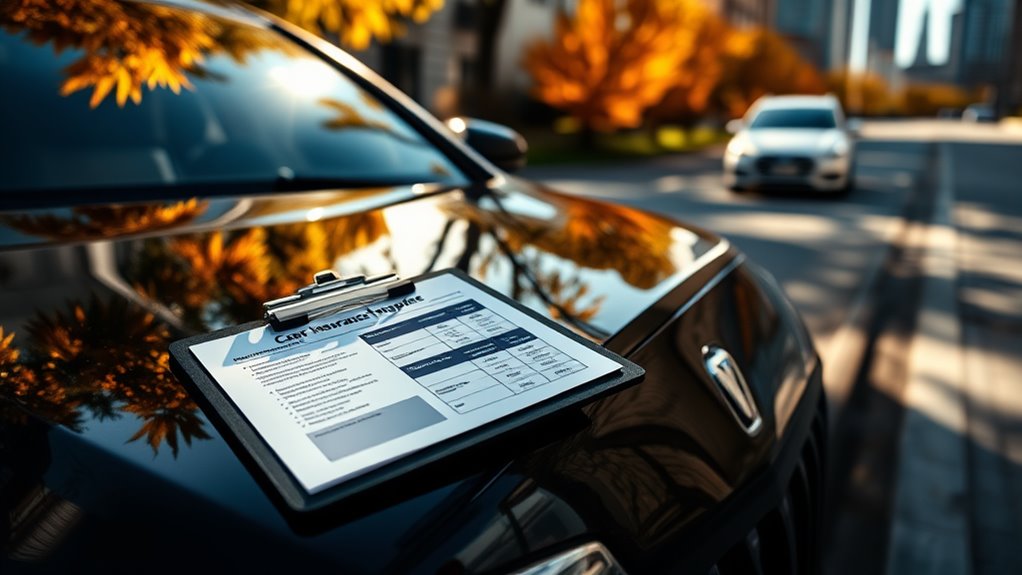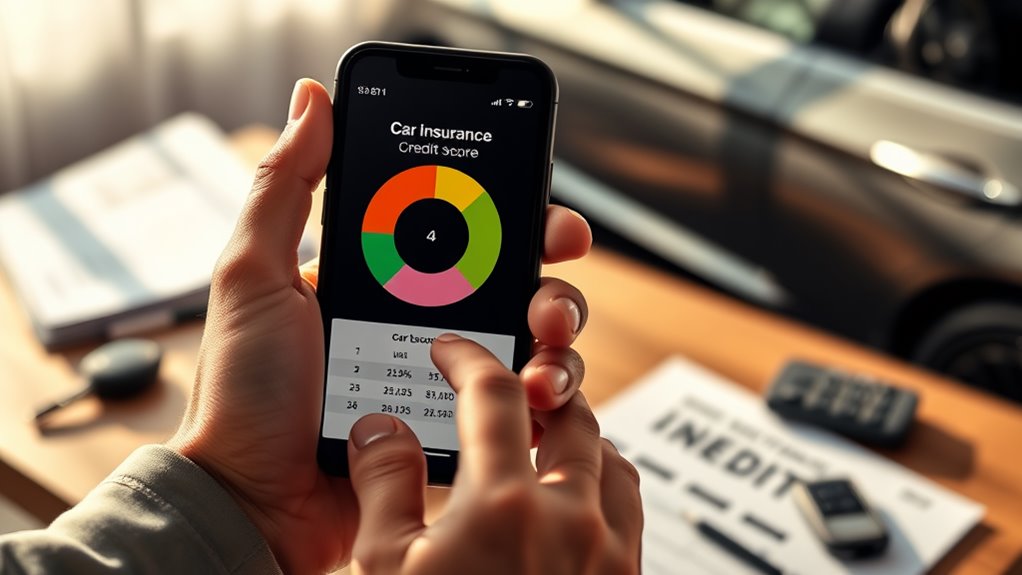When considering non-owner car insurance, understanding the top costs involved is vital. Premiums can vary considerably based on factors like your driving history, age, and location. For instance, while some providers may charge upwards of $500, others offer much lower rates. It's important to analyze these variations deeply, as they can impact your overall expenses. But what specific factors contribute to these differences, and how can you effectively navigate the landscape?
Key Takeaways
- The average annual cost of non-owner car insurance is approximately $325, with monthly rates around $27.
- Costs can range significantly from $177 to $641, influenced by location and driving history.
- GEICO and Travelers charge $463 and $511 annually, while State Farm offers the most affordable option at $213.
- USAA provides the lowest rate at about $177, emphasizing the need to compare quotes regularly.
- Premiums typically decrease with age, but can rise again after 65 due to increased accident risk.
Average Annual Costs of Non-Owner Car Insurance

When considering non-owner car insurance, you'll find that the average annual cost is around $325, translating to about $27 per month. However, this figure can fluctuate markedly based on several factors. Your geographical location plays an essential role; urban areas often have higher premiums than rural ones. Additionally, your driving history can impact rates, with accidents or speeding tickets potentially raising costs. While age and credit score typically matter less in non-owner policies, they still influence pricing in some states. Liability coverage is a fundamental aspect of non-owner car insurance that can also affect overall costs. Understanding how non-owner coverage works can provide clarity on the benefits and limitations of this type of policy. Insurers also vary in their quotes for similar coverage levels, so it's wise to shop around. Ultimately, non-owner policies generally cost less than standard insurance due to their reduced coverage scope and the assumption of lower driving frequency.
Cost Comparisons Among Top Providers
Understanding the costs associated with non-owner car insurance requires comparing rates from various providers.
For example, GEICO offers policies at $463 annually, while Travelers charges $511. State Farm typically provides the most affordable option at around $213 per year. In contrast, Progressive's non-owner policies cost approximately $656 annually, and USAA stands out with a rate of about $177.
These differences arise from factors like coverage options, driving frequency, and geographic location. While liability coverage is standard, additional features may increase costs.
Consequently, it's essential to research and compare quotes from multiple providers to find the best fit for your needs and budget, ensuring you meet state insurance requirements while securing the best rates.
Impact of Age and Driving Record on Rates
As drivers age and their experience grows, their non-owner car insurance rates often reflect this progression. Generally, premiums decrease with age until about 55, with middle-aged drivers typically enjoying the lowest rates due to their extensive experience.
However, teenage drivers face the highest premiums, as their inexperience presents a greater risk. After age 65, rates can rise again, reflecting the increased accident risk associated with older drivers.
Your driving record also plays a vital role; traffic violations and accidents can greatly hike premiums. Maintaining a clean driving record helps lower costs, while a DUI conviction can lead to substantial increases.
Insurers view both age and driving history as key indicators of risk, impacting your overall insurance expenses.
Regional Variations in Insurance Costs
Insurance costs vary considerably across regions, influenced by a complex interplay of factors. State regulations play a significant role, as minimum coverage requirements and additional protections like personal injury protection can drive up prices.
Urban areas, with their higher population density, face increased accident risks, theft, and vandalism, leading to elevated premiums compared to rural settings. Additionally, natural disasters—like hurricanes in Florida or wildfires in California—can drastically affect rates due to the increased likelihood of claims.
Poor road infrastructure in certain states can also contribute to higher costs. Lastly, local economic conditions and the cost of living directly influence insurance pricing, making it essential for you to understand these regional variations when evaluating your coverage options.
Frequency of Vehicle Use and Its Financial Implications
How often do you find yourself behind the wheel? Your driving frequency directly affects your insurance premiums. Frequent drivers typically face higher costs, especially if they've poor driving records.
Your driving frequency significantly influences your insurance premiums, with frequent drivers often facing higher costs.
Engaging in high-risk activities, like long-distance driving, further increases these premiums due to greater exposure. If you often borrow or rent vehicles, non-owner car insurance becomes vital, offering secondary coverage that protects you financially.
While non-owner insurance generally has lower premiums compared to traditional policies, customizing it based on your usage patterns is essential. Regularly reviewing your insurance can help manage costs, especially if you can take advantage of discounts for safe driving or low mileage.
Ultimately, understanding your driving habits helps optimize your insurance expenses.
The Role of SR-22 and FR-44 Forms in Pricing
Two essential forms, SR-22 and FR-44, greatly influence car insurance pricing for high-risk drivers. These forms serve as proof of financial responsibility, typically required after severe traffic violations.
While SR-22 is common across most states, FR-44 is specific to Florida and Virginia and demands higher liability coverage, especially for DUI offenses. Consequently, both forms lead to increased premiums due to the heightened risk perception.
Your driving record, state regulations, and chosen insurance provider further impact costs. Non-owner SR-22 policies, designed for those without vehicles, can offer a more economical option, but they still vary based on your history and location.
Understanding these factors is essential for maneuvering your insurance expenses effectively.
Coverage Options and Their Effect on Premiums
Selecting the right coverage options can greatly impact your premiums for non-owner car insurance. Understanding how each option affects your costs is vital. Here are four key coverage types to evaluate:
- Liability Coverage: Essential for protecting against damages to others, but higher limits can raise your premium.
- Uninsured/Underinsured Motorist Coverage: Adds a layer of protection, yet it typically increases your overall costs.
- Medical Payments Coverage: This can cover your medical expenses, affecting your premium based on the amount selected.
- Personal Injury Protection (PIP): Though beneficial, it may not be available in all states and can influence your premium.
Carefully weighing these options can help you find a balance between adequate protection and affordable premiums.
Additional Costs for High-Risk Drivers
When you're labeled a high-risk driver, the costs of non-owner car insurance can escalate quickly, greatly impacting your overall financial situation. Your premiums can increase by 30% to 80% due to traffic violations, accidents, or DUI convictions.
For instance, a single DUI conviction may spike your rates by an average of 79%. New and young drivers often face higher rates as well, given their limited experience.
Additionally, poor credit can further inflate your premiums, and some states impose extra fees like SR-22 certificates.
With fewer insurance providers willing to cover high-risk drivers, you might struggle to find affordable options, making it essential to explore strategies to mitigate these costs effectively.
Benefits of Maintaining Continuous Coverage
Maintaining continuous coverage offers significant advantages that can enhance your financial stability and insurance options. Here are some key benefits:
- Lower Premiums: You'll likely enjoy reduced rates thanks to a stable insurance history.
- Legal Compliance: Continuous coverage keeps you compliant with state laws, avoiding fines and legal issues.
- Financial Protection: You'll be protected from unexpected expenses due to accidents while uninsured.
- Lapse Prevention: By avoiding coverage gaps, you prevent being classified as a high-risk driver, which can lead to higher premiums.
Importance of Comparing Quotes Before Purchase
Comparing quotes before purchasing non-owner car insurance is vital for making an informed decision that fits your financial needs.
Costs can vary considerably, with annual premiums ranging from $177 to $641. By obtaining quotes from multiple providers, you guarantee you're not overpaying for similar coverage.
It's important to match coverage types across quotes to make accurate comparisons. Consider factors like your age, driving history, and state requirements, as these can greatly affect your premium.
Utilizing online tools or consulting independent agents can streamline this process. Regularly reviewing quotes at renewal time can lead to ongoing savings.
Ultimately, thorough comparison helps you find the best policy tailored to your unique requirements without unnecessary expenditures.
Conclusion
To sum up, while you might think non-owner car insurance is an unnecessary expense, it provides essential protection that can save you from hefty financial burdens in case of an accident. By comparing quotes and understanding your coverage options, you can find a plan that fits your budget. Don't let fear of high premiums hold you back; maintaining a clean driving record and continuous coverage can greatly lower your costs and give you peace of mind on the road.

















